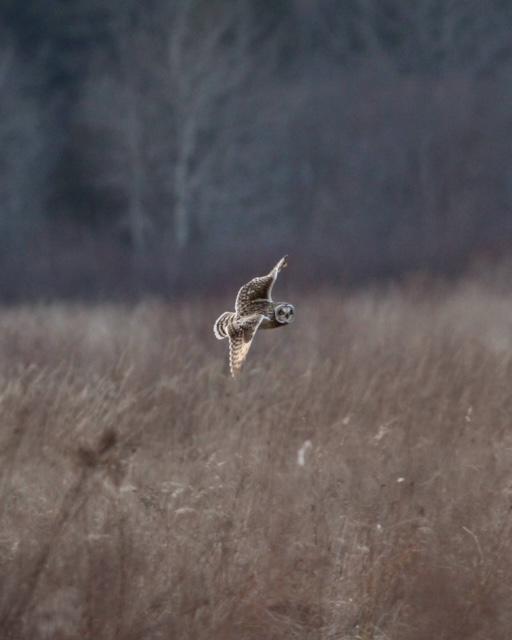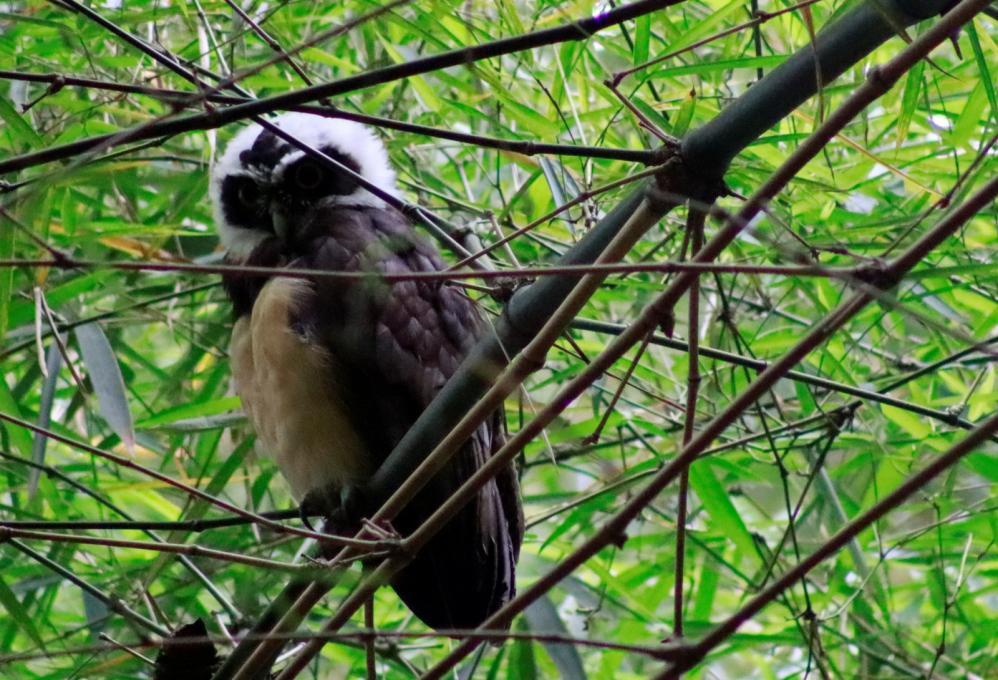The Cornell Lab Bird Academy › Discussion Groups › The Wonderful World of Owls › Young Owls Grow Up
-
Bird AcademyBird AcademyHow does the lifestyle of owls compare with other birds you know about? What things are similar and what are different?You must be enrolled in the course to reply to this topic.
-
Owls are very similar to other raptors, but they are incredibly adapted to hunting at night using their sight and hearing. I was suprised that larger owls can hunt smaller ones and that they don´t make their own nests.
-
I think it is very hard to tell young owls apart from each other because of the fluff and feather patterns.
-
If you compare owls to other raptors like eagles, I was surprised to learn that owls do not make their own nests. Instead, they inhabit tree cavities, man-made structures (such as chimneys) or abandoned nests, including abandoned bald eagle nests. Another surprising fact is that non-migratory owls don’t always reuse the same nest but move around depending on prey availability. While Eagles are active hunters’ owls use different strategies, such as the “sit and wait” method. Like owls, which can be migratory or non-migratory, eagles may be fully migratory, partially migratory or resident. However, most eagles migrate due to food-scarcity, whereas snowy owls, an irruptive species, migrate south not from a lack of food but due to booming lemming populations. A surplus of lemmings leads to increased snowy owl population, triggering migration south due to increased competition. Eagles and owls rarely interact since they hunt at different times (diurnal vs nocturnal). However, as apex predators, eagles also prey on smaller owl species. Both eagles and owls produce pellets, though eagles do so less frequently, and their pellets are smaller pellets and less compact.
-
Owls are nocturnal while most other birds are diurnal. Many other things like laying eggs and raising young are similar to other birds.
-
Owls, like most other birds, incubate eggs and defend and feed their young until they are ready to take off on their own. They will breed more successfully in the presence of plenty of food. Unlike many birds, they don’t build their own nests and take over suitable accommodations from others. They also regurgitate pellets instead of only eating what they can digest. Some migrate, but most are permanent residents in their ranges as long as there is plenty of food.
-
I knew that owls took other birds' nests, and they sometimes even hunt birds. Owls being mostly solitary, unlike a lot of other types of birds, did not surprise me either, but I did not know that some would nest together.
-
Owls fly, hunt for food, lay eggs, and raise their young like other birds. But they definitely have their own niche. They hunt at night. They use nests they find, rather than building their own nest. And most birds don’t regurgitate pellets like owls do. Many birds migrate; most owls stay in one place year-round. From time to time the Snowy Owls move south, much to the delight of birders in the Seattle area. I’ve seen Snowy Owls a couple of times. These gorgeous birds are easy to spot here since we normally don’t have snow on the ground.
-
The fact that owls are less social and more solitary than other birds definitely stands out to me. However, the way that the mother owls care for the eggs and the father owls find food for them is similar to the roles of parents with other bird species.
-
Similar: -like the potus, some owls have cryptic plumage, they hunt at night and they eat insects -an example is the Eastern Screech Owl -like all raptors, they have very strong talons and a broad diet; the talons are adapted to the particular food source - for example, a fish owl has large talons to catch fish similar to the golden eagle Different: -owls are different from other birds in that they sometimes use the abandoned nest of a rodent -with some exceptions, other birds do not regurgitate pellets
-
I'd never previously given thought to the differences in hunting styles between species of owls. Some hunt by sight and others totally by sound. Thinking about the night hunters, relying upon listening for prey, and then successfully catching the prey is pretty amazing to me. And I come back to the Great Gray Owl, who has been known to catch mice in 18 inches of snow..by sound. So fantastic.
-
They are similar in the sense that they mate, lay eggs in some sort of nest, incubate their eggs, raise their young. The main difference is the fact that they are active at night, whereas most other birds are active during the day. The shape of their eyes and the location of their eyes and ears in their skull is also different. How they utilize sight and hearing to find food explains why these differences are so pronounced.
-
I am impressed with how many mice some owls eat in a single day!
-
the lifestyle of owls is very different from other birds that I know about. Many other birds are carnivores like owls but they don't always behave in the way owls do. Owls are one of the only birds that can turn their heads 200 degrees in each direction. (Even though most owls rarely turn their head all that way) Even though owls aren't the only birds to cast pellets their way of eating food whole is almost entirely unique to them.(With the exception of other birds eating fish whole)
-
Recently, I've been fascinated by the analogous behavior of Short-eared owls and one of my other favorites, the Northern harrier. Both are grassland species and compete for the same food (voles and other small rodents). Both are ground nesting birds, and they even employ similar hunting strategies. Depending on the time of day, they will openly compete. I've kleptoparasitism in both birds against each other a few hours before dusk. Harriers even look more like owls than most hawks, as they rely on hearing in addition to their keen eyesight to capture prey that is hidden in thick grasses. So much fun to watch!

-
We had a Barred Owl nest in our backyard one year. They used an old Squirrel nest to raise their brood. They had three chicks. The chicks were so cute. I was surprised that they looked so much bigger than their parents. It was fun to watch them grow up and watch the parents feed them. I was surprised to see the parents active during the day. My husband was filling up the bird feeders one evening and the Mother Owl swoped down on him and hit his hat! Good thing he had his hat on. We have five acres in the woods. I love to hear the different owls calling to each other at night. I have seen Barn Owls, Barred Owls, and Great Horn Owls in our woods. It was a very interesting lesson. Interesting to learn that most owls are loners. Burrowing Owls live in colonies. Really enjoyed it.
-
It was alluded to in the lessons that several other birds cough up pellets, and I believe hawks and eagles (i.e. other birds of prey) are amongst those that do.
-
That was an interesting read for me as well, and I really wanted to know more. I'm not surprised if other raptors cough up pellets, but I look forward to reading more!
-
-
The nocturnal lifestyle of owls distinguishes them from many other bird species. Because owls consume food whole, they do not digest or pass certain materials (bone, fur, feathers) and need to regurgitate those as pellets. Owl pellets are a unique and useful way of understanding certain diets of specific owl groups. Like most birds, owls will lay and incubate their eggs, raise their young and care for their young for a while after hatching. They do not often build their own nests like most bird species do, and instead look for ready-made homes. Owls form pair-bonds to raise young, similar to other birds. Like other birds they return to the same nesting grounds year after year barring certain changes to the area.
-
 Spectacled Owl in Bucaramanga, Colombia.
Spectacled Owl in Bucaramanga, Colombia. -
I had never really considered where they nest and how little they prepare their nests. They are also somewhat unusual in that the female begins incubating immediately after the start of laying, so that the young are not all exactly the same age. I wonder if this affects the younger ones? Do they learn by watching their older siblings? Does this give them an advantage? I like that owls are nocturnal and I love listening to their songs and calls (both live and recorded). I really enjoy hearing the little screech owls around our house. Sometimes there are many and seem to be calling from all around us. Especially in late summer. The duets are rather unusual for birds, I think. I guess a bird pair that relies a lot on sound really does need to vocalize with each other.
-
With birds that use this strategy (asynchronous hatching), juveniles that hatch later are usually at a disadvantage to their older and bigger, stronger, noisier siblings who can out-compete them for food. In years where food is scarce, younger and smaller hatchlings may die if they are under-fed. It actually functions to give the parents the best reproductive success, as rather than distributing scarce food amongst all their offspring, which may mean that none are particularly well nourished, this strategy ensures that the strongest and most viable chicks get the best nutrition possible, increasing their chances of survival.
-
-
They lay eggs and incubate eggs.and care for their young like other birds.But they hunt at night.
-
Despite their mysterious reputation, the lives of owls are more similar, than different, to other familiar birds, especially cavity nesters. Possible exceptions are owls "superpowers", or adaptations for hunting at night, as most species are nocturnal. Also, young owls seem to leave the nest fairly early, so they are able to "branch" into nearby trees, for protection from possible predators.
-
Similar - they fly and eat Different - most of the activity is done at night
-
The most striking difference between the lifestyle of owls and other birds is their adaptation to the night. I have always been fascinated by nocturnal animals who adapt to this very different way of living. Owls, like other birds, build nests, lay eggs, incubate those eggs, and care for thier young.
-
I don't know well the behavoir of night bird to compare. I m very impresive about owl, thier capacity to fly with no noise, to ear with such precision, to see with a few light. I wouold lie to know how can i swatch them, i have never see one
Read More:

 Spectacled Owl in Bucaramanga, Colombia.
Spectacled Owl in Bucaramanga, Colombia.